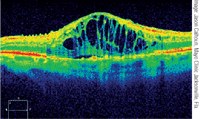Q: I comanage with several different cataract surgeons, and they all have different pre- and post-op regimens for their patients. Why is that?

A: Some ophthalmologists may favor a perioperative medical regimen that differs from the one to which you are accustomed.
Differences of approach often hinge on three questions: Is there evidence that a particular regimen is efficacious in a pre- or postoperative setting? Does a certain medication needlessly add to the patient’s treatment burden in terms of cost and complexity? And what is the standard in the community?
All three issues arise preoperatively as well as postoperatively. For example, many doctors favor prescribing a topical broad-
spectrum fluoroquinolone three days before surgery to reduce the risk of intraoperative endophthalmitis.
In theory, this makes sense. “Yet, there is no persuasive evidence to suggest this is an effective strategy,” says Christopher Quinn, O.D., president of Omni Eye Center in Iselin, N.J.
Another preoperative question surrounds the use of nonsteroidal anti-inflammatory drugs (NSAIDs). Topical agents such as Voltaren (diclofenac, Novartis) Acuvail (ketorolac, Allergan), Nevanac (nepafenac, Alcon) or Bromday (bromfenac, ISTA) are thought to reduce the risk of postoperative cystoid macular edema (CME). Here, too, there is little evidence that this is an effective strategy, especially considering the high cost of the drops.
Shifting to postoperative management, the standard regimen for many years has called for a topical broad-spectrum antibiotic, a topical steroid and possibly an NSAID. Not long ago, drug companies even provided postoperative kits containing a starter sample of an antibiotic, a steroid, and an eye shield all in a handy bag. “That way, you could be sure the patient got his or her meds in that crucial early period,” Dr. Quinn says.
But, the post-op kits have gone away due to pharma regulations, and the question still arises about the necessity of that post-op NSAID.

Are postoperative NSAIDs necessary to reduce the risk of cystoid macular edema? Maybe NSAIDs should be reserved for high-risk patients.
“Many surgeons have promoted the routine use of NSAIDs postoperatively to reduce inflammation and the risk of postoperative cystoid macular edema,” Dr. Quinn says.
But, the evidence is not compelling. “When you look at patients following surgery, and if you test them with either an OCT or fluorescein angiography, a fairly high percentage of patients will have subclinical CME that doesn’t necessarily affect vision,” Dr. Quinn says. “So, the question is: Do we give the patient a medication to prevent a potential complication? Or do we treat a complication like subclinical CME when we don’t know if it has any impact on their vision?”
So how do you proceed?
“We don’t use an NSAID routinely,” Dr. Quinn says. “We use it for what we consider high-risk patients. That includes patients who are diabetic or who have a broken posterior capsule during the course of surgery—the types of situations where the risk of CME may be higher.”
In a cost-benefit analysis, if there were no constraints on finance or complexity, you might put the patients on all three drops following surgery, he says.
Dr. Quinn is not alone. He surveyed doctors at 14 eye care comanagement centers nationwide on the routine use of NSAIDs before and after cataract surgery. Results: 20% of doctors use them routinely, while 80% reserve their use for high-risk patients.

